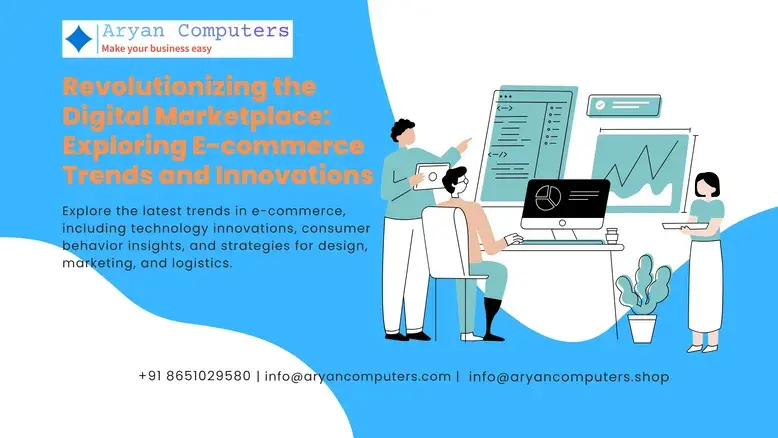The e-commerce world has changed a lot lately. New tech and what people want have changed how businesses work online. This guide covers e-commerce solutions, technology trends, consumer behavior, design and development, marketing strategies, and payment and logistics. It shows what makes a business successful online today.
1. E-commerce Solutions and Online Shopping Trends
E-commerce Platforms
Platforms like Shopify, WooCommerce, and BigCommerce make it easy for any business to sell online. They are easy to use, grow with your business, and work well with other tools.
Mobile Commerce (M-Commerce)
More than 60% of online shopping comes from mobile devices. Businesses need to focus on mobile to improve user experience and reach more customers.
Social Commerce
Platforms like Instagram and TikTok are now places to buy things. They make it easy to shop from posts and pay right away.
Omnichannel Retail
Customers want a smooth shopping experience online and offline. Omnichannel strategies help by keeping everything consistent and easy to use.
2. Technology Trends in E-commerce
Artificial Intelligence (AI) and Machine Learning
AI is changing how we shop online. It uses data to suggest products, set prices, and manage stock.
Voice Commerce
Voice assistants like Alexa and Google Assistant make shopping easier. They let you add items and pay with just your voice.
Augmented Reality (AR) and Virtual Reality (VR)
AR lets you see products in your space. VR offers virtual try-ons. These techs make online shopping feel more real.
Blockchain in E-commerce
Blockchain makes transactions safe and transparent. It also makes supply chains more efficient and easier to track.
Headless Commerce
Headless commerce separates the front-end and back-end of online stores. This lets businesses create unique experiences on different devices and channels.
3. Shifting Consumer Behavior
Personalized Shopping Experience
Customers want shopping experiences that are just for them. Personalization builds loyalty and increases sales.
Subscription-Based Services
Services like Amazon Prime or Birchbox offer ongoing value. They provide convenience and steady income for businesses.
Buy Now Pay Later (BNPL)
BNPL options like Klarna and Afterpay let people buy now and pay later. This makes shopping more flexible.
Sustainable Shopping
More people want to shop from brands that care about the planet. Green practices are now a must for businesses.
Hyperlocal Delivery and Fast Shipping
Fast and local delivery is in demand, especially in cities. It offers speed and convenience to customers.
4. Design and Development for Modern E-commerce
Mobile-First Design
Designing for mobile first makes shopping easier and more accessible. It's all about responsive layouts, touch-friendly interfaces, and quick loading times.
Progressive Web Apps (PWAs)
PWAs offer the best of both web and app worlds. They provide offline access, push notifications, and fast speeds to keep users engaged.
UX/UI Optimization
Good design means simple navigation, easy-to-use layouts, and eye-catching visuals. This makes shopping smooth and boosts sales.
Secure Payment Gateways
Using secure gateways like Stripe and PayPal builds trust. They use advanced encryption and multi-factor authentication to fight fraud.
Data Security in E-commerce
With more cyber threats, strong security is key. Businesses need SSL certificates, firewalls, and encryption to protect user data.
5. Marketing and Engagement Strategies
Social Media Integration
Connecting social media with e-commerce sites makes sharing and sales easy. It also encourages user-generated content.
Influencer Marketing
Working with influencers boosts brand reach and authenticity. It drives engagement and sales.
Livestream Shopping
Live video sessions combine entertainment with shopping. They attract a younger audience and increase sales.
Customer Retention Strategies
Loyalty programs and personalized service build lasting relationships. They keep customers coming back.
Loyalty Programs
Rewards like points and discounts keep customers loyal. They also increase the value of each customer over time.
6. Payment and Logistics in E-commerce
Digital Wallets and Cryptocurrency Payments
Digital wallets like Apple Pay make payments easy. Cryptocurrency options like Bitcoin appeal to tech-savvy shoppers.
Multi-Channel Payment Solutions
Offering many payment options makes shopping accessible. It also reduces cart abandonment.
Inventory Management Systems
Automated inventory tracking prevents stockouts and overstocking. It makes operations more efficient.
Advanced Logistics
New logistics like drone deliveries and AI route optimization are changing shipping. They make it faster and more reliable.
Conclusion
The e-commerce world is changing fast. Businesses need to be quick and creative to succeed. By focusing on customers and using new technologies, brands can grow a lot in the digital market.

